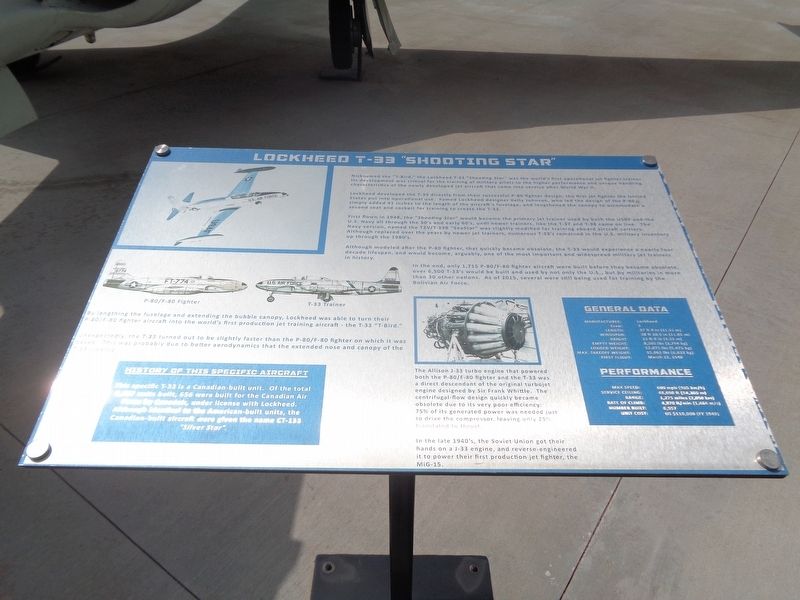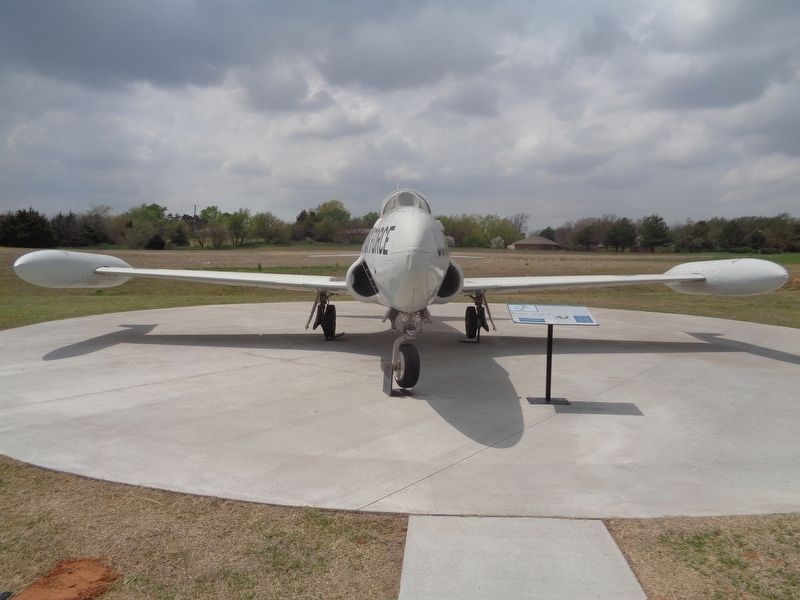Weatherford in Custer County, Oklahoma — The American South (West South Central)
Lockheed T-33 "Shooting Star"
Lockheed developed the T-33 directly from their successful P-80 fighter design, the first jet fighter the United States put into operational use. Famed Lockheed designer Kelly Johnson, who led the design of the P-80, simply added 41 inches to the length of the aircraft's fuselage, and lengthened the canopy to accommodate a second seat and cockpit for training to create the T-33.
First flown in 1948, the "Shooting Star" would become the primary jet trainer used by both the USAF and the U.S. Navy all through the 50's and early 60's, until newer trainers, lie the T-37 and T-38 came on line. The Navy version, named the T2V/T-33B "SeaStar" was slightly modified for training aboard aircraft carriers. Although replaced over the years by newer jet trainers, numerous T-33's remained in the U.S. military inventory up through the 1980's.
Although modeled after the P-80 fighter, that quickly became obsolete, the T-33 would experience a nearly four decade lifespan, and would become, arguably, one of the most important and widespread military jet trainers in history.
In the end, only 1,715 P-80/F-80 fighter aircraft were built before they became obsolete, over 6,500 T-33's would be built and used by not only the U.S., but by militaries in more than 30 other nations. As of 2015, several were still being used for training by the Bolivian Air Force.
By lengthing the fuselage and extending the bubble canopy, Lockheed was able to turn their P-80/F-80 fighter aircraft into the world's first production jet training aircraft - the T-33 "T-Bird."
Unexpectedly, the T-33 turned out to be slightly faster than the P-80/F-80 fighter on which it was based. This was probably due to better aerodynamics that the extended nose and canopy of the T-33 creates.
The Allison J-33 turbo engine that powered both the P-80/F-80 fighter and the T-33 was a direct descendant of the original turbojet engine designed by Sir Frank Whittle. The centrifugal-flow design quickly became obsolete due to its very poor efficiency: 75% of its generated power was needed just to drive the compressor, leaving only 25% translated to thrust.
In the late 1940's, the Soviet Union got their hands on a J-33 engine, and reverse-engineered it to power their first production jet fighter, the MiG-15.
(sidebars:)
History of this specific aircraft
This specific T-33 is a Canadian-built unit. Of the total 6,557 units built, 656 were built for the Canadian Air Force by Canadair, under license with Lockheed. Although identical to the American-built units, the Canadian-built aircraft were given the name CT-133 "Silver Star".
General Data
Manufacturer: Lockheed
Crew: 2
Length: 37 ft 9 in (11.51 m)
Wingspan: 38 ft 10.5 in (11.85 m)
Height: 11 ft 8 in (3.55 m)
Empty weight: 8,365 lbs (3,794 kg)
Loaded weight: 12,071 lbs (5,475 kg)
Max. takeoff weight: 15,061 lbs (6,832 kg)
First flight: March 22, 1948
Performance
Max speed: 600 mph (965 km/h)
Service ceiling: 48,000 ft (14,360 m)
Range: 1,275 miles (2,050 km)
Rate of climb: 4,870 ft/min (1,484 m/s)
Number built: 6,557
Unit cost: US $100,000 (FY 1949)
Topics. This historical marker is listed in this topic list: Air & Space. A significant historical date for this entry is March 22, 1948.
Location. 35° 32.642′ N, 98° 40.243′ W. Marker is in Weatherford, Oklahoma, in Custer County. Marker is on Logan Road west of Jim Cobb Drive, on the right when traveling east. Marker is outside the Stafford Air & Space Museum. Touch for map. Marker is at or near this postal address: 3000 Logan Rd, Weatherford OK 73096, United States of America. Touch for directions.
Other nearby markers. At least 8 other markers are within 6 miles of this marker, measured as the crow flies. Fairchild-Republic A-10 "Thunderbolt II" (within shouting distance of this marker); Apollo Command Module (within shouting distance of this marker); Lockheed F-104C "Starfighter" (within shouting distance of this marker); Lt. Gen. Thomas P. Stafford (within shouting distance of this marker); McDonnell-Douglas F-4C Phantom II (approx. half a mile away); Provine/Hamons' Station (approx. 4.7 miles away); The Baldwin Bridge (approx. 5.2 miles away); Hydro Veterans Memorial (approx. 5.8 miles away). Touch for a list and map of all markers in Weatherford.
Also see . . .
1. Lockheed T-33 on Wikipedia. (Submitted on June 19, 2021, by Jason Voigt of Glen Carbon, Illinois.)
2. Stafford Air & Space Museum. Official website (Submitted on June 19, 2021, by Jason Voigt of Glen Carbon, Illinois.)
Credits. This page was last revised on June 19, 2021. It was originally submitted on June 19, 2021, by Jason Voigt of Glen Carbon, Illinois. This page has been viewed 184 times since then and 9 times this year. Photos: 1, 2. submitted on June 19, 2021, by Jason Voigt of Glen Carbon, Illinois.

